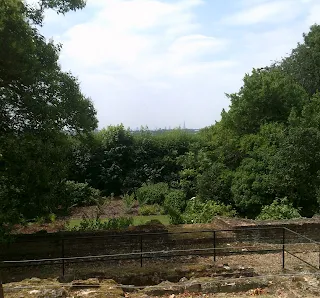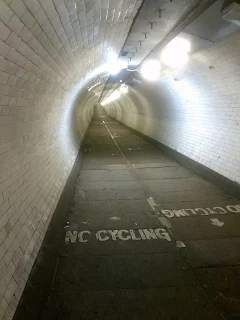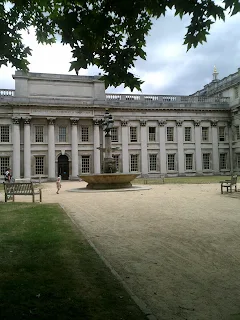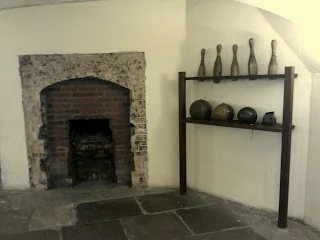When my SuperDean said he fancied a day out, my first thought was Kew Gardens. After all, it's been a year since I was last there (two years for him) and the Temperate House is now re-open.
BUT...... the place involves a hell of a lot of walking (I beg to differ with travel sites that say it can be traversed in 2-3 hours, when 4-5 hours is more like it) and that's not always a pleasure in 25 degrees of heat. Also, hothouses are hardly going to offer a welcome respite and the Pagoda is still closed for refurbishment.
So, I knocked that idea on the head.
'Eltham Palace?' I suggested. It's our side of London, can be seen in 2 hours and sightseeing is mostly indoors but with a garden that is a pleasure on a clement day. I know I only visited (alone) a few weeks ago but I adored the place, PLUS I missed seeing the cage of Mah-Jongg, Virginia Courtauld's pet lemur.
So, Eltham Palace it was.
Here are the things I missed on my previous visit.
This little triangular garden once served as the kitchen garden...
Ta ta for now.
XXXXXXXXXXXXXX
Here are the things I missed on my previous visit.
This little triangular garden once served as the kitchen garden...
Looking over to the Rock Garden...
The little rockery cascade was worth a couple of photos...
The Loggia. The reliefs depict some of the interests of Stephen and Virginia Courtauld, which include: gardening, sports, sailing and mountaineering...
My SuperDean heading towards the Pergola...
The supporting stone columns were salvaged from the Bank of England in the 1930s and are probably late 18th century.
Lovely wisteria covers the Pergola...
Next to the heart of the Pergola lies a mulberry tree, which grows at an interesting angle from the ground. From my close viewpoint I couldn't fit it all onto my camera- so I photographed it in two parts!
We walked around the corner and saw the Great Hall from this end...
There are tables and chairs dotted about throughout the grounds, so we enjoyed the shade of a big tree for a little while...
Gorgeous waterlilies (but no frogs!)
As we walked away, towards the main entrance of the house, I took a photo of this rather cute door right near the north stone bridge...
And now we come to Mah-Jongg. He was known as Jonggy (pronounced 'Johnny') and was Virginia Courtauld's ring-tailed lemur. Stephen purchased him as a wedding present to his wife, in 1923, and he lived until 1938.
He was the world's most spoiled lemur and he certainly got lucky the day Stephen bought him from Harrods. He got to accompany the Courtaulds not only throughout their changes of residence, but also on their travels.
The following three pictures have been lifted from the Eltham Palace tourist guidebook.
Here is a painting of Stephen and Virginia Courtauld striking an elegant pose with their pet...
Inside his centrally heated cage at Eltham...
This was taken on the Courtauld's yacht, where Jonggy had his own deckchair. And what a poser he is! I mean, really!!!
I remember walking past his cage last time but its presence, for some reason, didn't grab me. It was surrounded by children, as it was half term, and I remember seeing a reference note mentioning mah-jongg (which I know is a Chinese game) and getting the most cursory glimpses of a stuffed animal, but I assumed it was the nursery and decided to do that part later. At the time, I didn't know that the Courtaulds were childless and I simply forgot about the cage.
The walls of Jonggy's cage are decorated with Madagascan bamboo forest scenes, to make him feel at home...
There is a trapdoor in the corner with a bamboo ladder leading from it, which allowed him to access the ground floor during the day...
The ladder comes down just behind the Flower Room. Again, I totally missed this the last time I was here and had to search for it this time as it's not immediately obvious.
We were given a lovely talk about the history of the palace in the Great Hall. Jonggy is depicted on the ceiling here. It's a actually a wood carving, made to look like stone, and he is the centrepiece.
I tried to crop the photo, to show you a close-up...
It's not great, so here's a picture of a picture held by David (the guide giving the talk).
Mah-Jongg is also featured in this mural down in the basement. God, he must have been sooooo loved! I don't blame the Courtaulds- he was supremely cute...
...but he was known to take a chunk out of people to whom he took a dislike. Here is a lemur care kit, which features iodine for treating bites...
After my last visit, I had to order my own Jonggy. This little fella came from eBay...
I also thought I'd quite like a red dress similar in style to Virginia's in the photo. I ordered this from eBay and it cost me a tenner (I don't spend a fortune on clothing- I know how much these rags cost to make, thank you very much). I'm not sure if it's going to suit me but, if it doesn't, then I will put it under the sewing machine and alter it until it does!
Lets complete this blog with a couple of random, interesting photos.
And of course, I have to be lavatorial (literally!)
I didn't spot it before, but there's a big hole in this toilet. I remember, many moons ago, visiting a tacky nightclub in Bognor Regis. I had a couple of drinks, went to the loo and couldn't help but notice my feet getting wet. It was only when I got up and flushed that water belched out in a gush, and I spotted a sizeable hole like this in the front of the bog. Urgh! Thank God I hadn't needed a number two!
Finally, the view from outside, looking over at London. You can just about make out the Shard.
Ta ta for now.
XXXXXXXXXXXXXX




































































